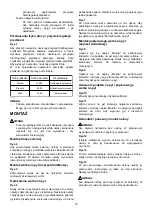
4
ENGLISH (Original instructions)
Explanation of general view
1-1. Red indicator
1-2. Button
1-3. Battery cartridge
2-1. Star marking
3-1. Stop button
3-2. Start/speed adjusting button
4-1. Pad
4-2. Abrasive disc
5-1. Dust bag
6-1. Dust nozzle
7-1. Dust nozzle
8-1. Holding tab
9-1. Dust box
9-2. Dust nozzle
10-1. Latch
10-2. Dust nozzle
13-1. Skirt
13-2. Screw
14-1. Skirt
16-1. Sponge pad
17-1. Felt pad
18-1. Wool pad
SPECIFICATIONS
Model DBO140
DBO180
Paper size
125 mm
Low speed
7,000
Middle speed
9,500
Orbits per minute(min
-1
)
High speed
11,000
Dimensions
175 mm x 123 mm x 153 mm
Net weight
1.6 kg
1.7 kg
Rated voltage
D.C. 14.4V
D.C. 18V
• Due to our continuing program of research and development, the specifications herein are subject to change without notice.
• Specifications and battery cartridge may differ from country to country.
• Weight, with battery cartridge, according to EPTA-Procedure 01/2003
ENE052-1
Intended use
The tool is intended for the sanding of large surface of
wood, plastic and metal materials as well as painted
surfaces.
ENG905-1
Noise
The typical A-weighted noise level determined according
to EN60745:
Model DBO140
Sound pressure level (L
pA
) : 78 dB (A)
Uncertainty (K) : 3 dB (A)
The noise level under working may exceed 80 dB (A).
Model DBO180
Sound pressure level (L
pA
) : 77 dB (A)
Uncertainty (K) : 3 dB (A)
The noise level under working may exceed 80 dB (A).
Wear ear protection
ENG900-1
Vibration
The vibration total value (tri-axial vector sum)
determined according to EN60745:
Model DBO140
Work mode : sanding metal plate
Vibration emission (a
h
) : 2.5 m/s
2
or less
Uncertainty (K) : 1.5 m/s
2
Model DBO180
Work mode : sanding metal plate
Vibration emission (a
h
) : 2.5 m/s
2
or less
Uncertainty (K) : 1.5 m/s
2
ENG901-1
•
The declared vibration emission value has been
measured in accordance with the standard test
method and may be used for comparing one tool
with another.
•
The declared vibration emission value may also be
used in a preliminary assessment of exposure.
WARNING:
•
The vibration emission during actual use of the
power tool can differ from the declared emission
value depending on the ways in which the tool is
used.
•
Be sure to identify safety measures to protect the
operator that are based on an estimation of
exposure in the actual conditions of use (taking
account of all parts of the operating cycle such as
the times when the tool is switched off and when it
is running idle in addition to the trigger time).





































